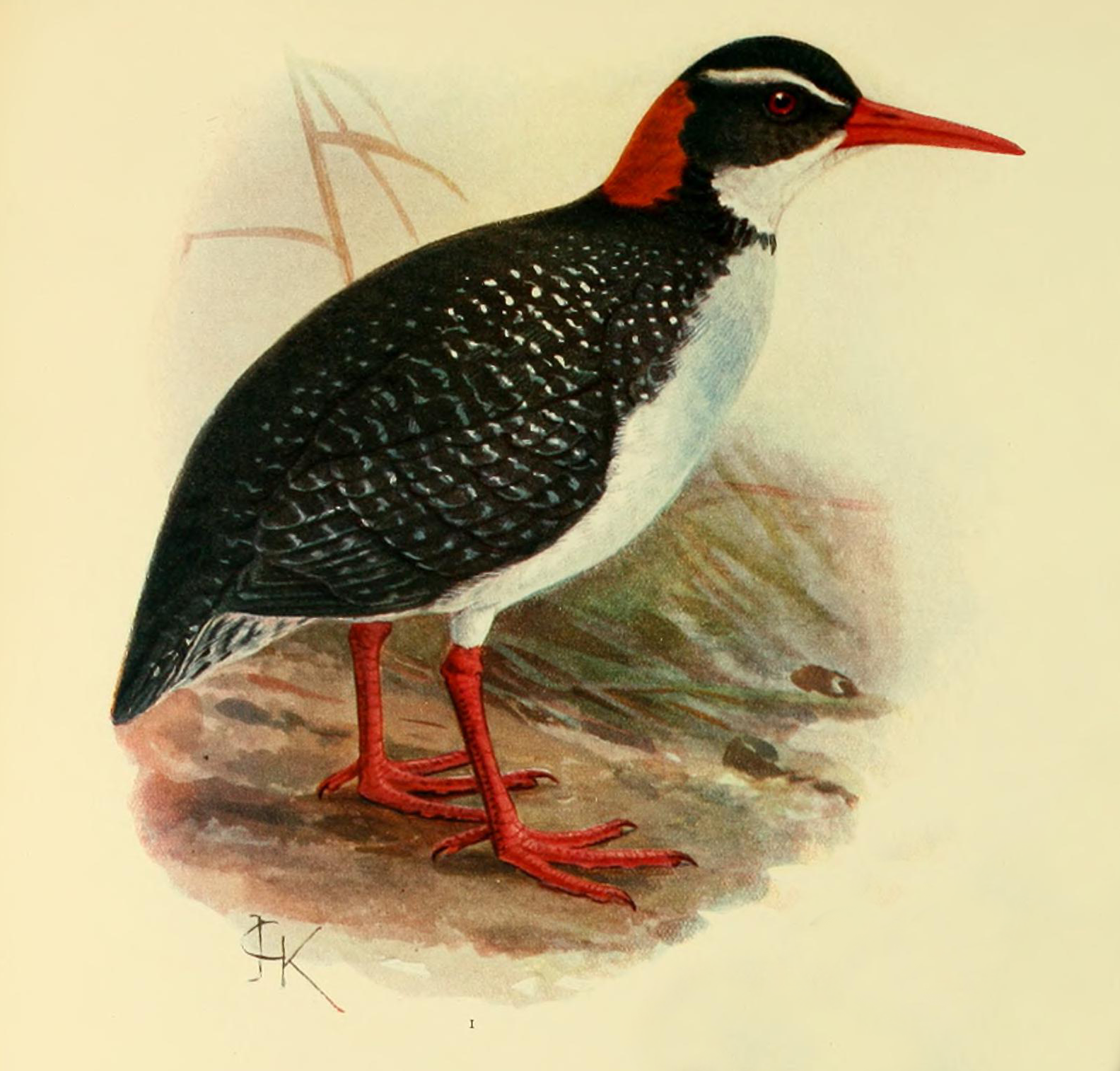Hypotaenidia pacifica (Gmelin, 1789:717)
Tahitian red-billed rail, Tahiti rail
Taxonomy & Nomenclature
Synonym/s: Rallus pacificus Gmelin, 1789:717; Gallirallus pacificus (Gmelin, 1789:717)
Conservation Status
Extinct (WCMC, 1992:212)
Last record: 1773 (1844?;1930's according to Bruner, 1972); 1773-1774 (WCMC, 1992:212); 1935 (Kittelberger et al., 2024)
IUCN RedList status: Extinct
Distribution
Mehetia & Tahiti, Windward group, Society Islands
Biology & Ecology
Hypodigm
Media

Above: part of Plate 26 in Rothschild (1907). Source: Wikimedia Commons.
References
Original scientific description:
Gmelin, Johann Friedrich (1879): [Description of Gallirallus pacificus]. In: Systema Naturae (13th edition) 1, part 2: 717.
Other references:
BirdLife International (2000) Threatened Birds of the World. Lynx Edicions and BirdLife International, Barcelona and Cambridge.
BirdLife International. (2012). Gallirallus pacificus. In: IUCN 2013. IUCN Red List of Threatened Species. Version 2013.1. (http://www.iucnredlist.org). Downloaded on 24 August 2013.
BirdLife International. 2016. Hypotaenidia pacifica. The IUCN Red List of Threatened Species 2016: e.T22692450A93354380. https://dx.doi.org/10.2305/IUCN.UK.2016-3.RLTS.T22692450A93354380.en. Downloaded on 27 June 2021.
Brooks, T. 2000. Extinct species. In: BirdLife International (ed.), Threatened Birds of the World, pp. 701-708. Lynx Edicions and BirdLife International, Barcelona and Cambridge, U.K.
Bruner, P. L. (1972). The birds of French Polynesia. Honolulu: Bernice P. Bishop Museum.
del Hoyo, J., Collar, N.J., Christie, D.A., Elliott, A. and Fishpool, L.D.C. 2014. HBW and BirdLife International Illustrated Checklist of the Birds of the World. Volume 1: Non-passerines. Lynx Edicions BirdLife International, Barcelona, Spain and Cambridge, UK.
del Hoyo et al. (2019) Handbook of The Birds of the World
Fuller, Errol. (1988). Extinct Birds. New York: Facts on File Publications. 256 pp.
Fuller, Errol. (2000). Extinct Birds, revised edition. Oxford: Oxford University Press.
Greenway, J. C. (1967). Extinct and Vanishing Birds of the World. Dover Publications, New York.
Hume, Julian Pender and Walters, Michael. (2012). Extinct Birds. London: T & AD Poyser.
Kittelberger, Kyle D., Tanner, Colby J., Buxton, Amy N., Prewett, Amira and Şekercioğlu, Çağan Hakkı. (2024). Correlates of avian extinction timing around the world since 1500 CE. Avian Research 15: 100213. https://doi.org/10.1016/j.avrs.2024.100213 [Supplementary data (List of 216 taxa)]
Knox, Alan G. and Walters, Michael P. (1994). Extinct and endangered birds in the collections of The Natural History Museum. British Ornithologists' Club Occasional Publications 1: 1-292.
Lysaght, A. (1953). A rail from Tonga. Bull. Brit. Orn. Club 73: 74-75.
Ripley, S. D. (1977). Rails of the world. Boston, MA: David R. Goodine.
Rothschild, Lionel Walter. (1907). Extinct birds: an attempt to write in one volume a short account of those birds which have become extinct in historical times, that is within the last six or seven hundred years: to which are added a few which still exist, but are on the verge of extinction. London: Hutchinson & Co. XXIX + 243 pp. [p. 123, pl. 26]
Sayol, Ferran, Steinbauer, Manuel J., Blackburn, Tim M., Antonelli, Alexandre and Faurby, Søren. (2020). Anthropogenic extinctions conceal widespread evolution of flightlessness in birds. Science Advances 6(49): eabb6095. https://doi.org/10.1126/sciadv.abb6095 [Supplementary Material (Data File S1)]
Stattersfield, A. J.; Crosby, M. J.; Long, A. J.; Wege, D. C. (1998). Endemic bird areas of the world: priorities for bird conservation. BirdLife International, Cambridge, U.K.
Taylor, P. B. and Van Perlo, B. (1998). Rails: A Guide to the Rails, Crakes, Gallinules and Coots of the World. Robertsbridge: Pica Press.
Tyrberg, Tommy. (2009). Holocene avian extinctions, pp. 63-106. In: Turvey, Samuel T. (ed.). Holocene Extinctions. Oxford, UK & New York, USA: Oxford University Press. xii + 352 pp.
WCMC (World Conservation Monitoring Centre). (1992). Global Biodiversity: Status of the Earth's living resources. London: Chapman & Hall. xx + 594 pp.
